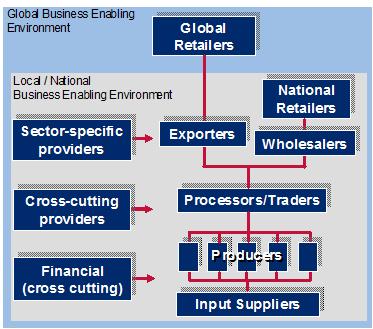1.3.5. Supporting Markets - Overview
What are Supporting Markets?
Image

Supporting markets offer products and services in support of a range of business functions to actors throughout a value chain. Many of the services provided by supporting markets correspond to non-financial services referred to by some as business development services or BDS. These include training, consulting and accounting. However, supporting markets in USAID’s value chain framework are more varied than simple business services, and they include a broad range of financial and nonfinancial products and services. These products and services can be divided into three main categories:
- Financial services--e.g., lending, leasing, capital investing, factoring
- Cross-cutting services--e.g., business consulting, legal advice, telecommunications, advertising
- Sector-specific services--e.g., irrigation equipment, veterinary services, handicraft design services
Supporting-market products and services are provided for a fee by businesses of all sizes--from independent consultants or local vendors to global firms. Value chain actors typically pay this fee because of the value the product or service provides to them and/or because it is not practical or cost-effective to provide the product or service themselves. Some common services that businesses pay for include tax and accounting services, waste management, and information and communications technology services.
Alternatively, value chain actors may acquire embedded products or services from their buyers or suppliers in the value chain. Some of the more commonly embedded products and services include equipment supply, input and raw material supply, market information, financing and technical training.
Supporting markets comprise businesses whose viability and growth are derived from demand for their products and services from client businesses. The growth and competitiveness of supporting markets is therefore limited by the growth and competitiveness of the value chains they serve. At the same time, robust supporting markets are essential for the continued growth and competitiveness of value chain actors since the products and services they provide enable value chain actors to upgrade their own products and operations. Furthermore, when relationships among supporting-market businesses are strong, value chain actors benefit from having partners who can supply information on market trends and innovations and provide access to the latest techniques and technologies that provide further upgrading opportunities.
Why Do Supporting Markets Matter?
For development practitioners, supporting markets matter for two reasons. First, facilitation assistance is often needed to connect a budding demand for supporting market products and services with a nascent or non-existent supply. Facilitation assistance may be needed, for example, when supporting market businesses sluggishly respond to new demand from value chain actors, or when value chain actors are unable to communicate demand to potential providers. Often in the latter case, the demand may be fragmented among many small-sized value chain actors and as such goes unperceived or undervalued by supporting market businesses. In other cases, the value chain actors themselves are unaware that they have a problem that could be solved cost-effectively by another business.
Second, and most importantly, supporting-market businesses can be viable sources of assistance to value chain actors that can exist and grow beyond the life of a value chain development project. When supporting-market businesses enter into relations with value chain actors, and recognize that the successes of their respective businesses are intertwined, these relations have the potential to achieve the robustness typified in competitive industries.
Promotion of Supporting Markets
In value chain development programs, practitioners are interested in strengthening commercial relations that will result in improved competitiveness and greater benefit flows throughout the chain. While supporting markets are important for growth and competitiveness, they need not always be a component of a value chain development project; on the other hand, sometimes practitioners will be involved in strengthening supporting-market industries as value chains in their own right. For example, a project in Zambia targeting the livestock value chain focused much of its efforts on creating a competitive veterinary industry that was responsive to the needs of small-scale livestock producers.
What role to play and how to promote a supporting market should be based on the following considerations:
- Are there supporting markets whose products or services can resolve critical constraints to the competitiveness of the targeted value chain?
- Can the businesses in the supporting market be commercially sustainable by the end of the project? And, can supporting markets be made to see target value chain participants as viable clientele? Will the demand from actors in the targeted value chain be sufficient for supporting-market businesses to profit and grow? Conversely, can existing supporting market businesses be brought to see actors in the targeted value chain as a valuable market for their products or services? If the answers are no, then alternative approaches, such as embedded services should be explored.
- In the targeted value chain, is there a stronger rationale for promoting the needed products or services as embedded in relations between, for example, producers and their buyers? One strong rationale might be that producers in the value chain do not have the scale to afford stand-alone products and services. Another might be that value chain actors (that transact with producers) have strong incentives to develop, improve or expand the provision of embedded products or services. A third rationale might be the potential to signal to supporting market businesses i) the demand for such services and ii) the potential value of investing in developing their own capacity to provide these services.
To promote the development of commercially viable supporting-market products and services practitioners may intervene to i) help supporting-market businesses overcome constraints to providing products or services in a commercially viable manner and ii) ensure that these businesses are not dependent on project activities for continued provision beyond the life of the project. To achieve these objectives, project implementers must first analyze the relationships among supporting-market businesses and value chain actors.
Resources
For tools and resources for analysis of supporting markets, please click here.

